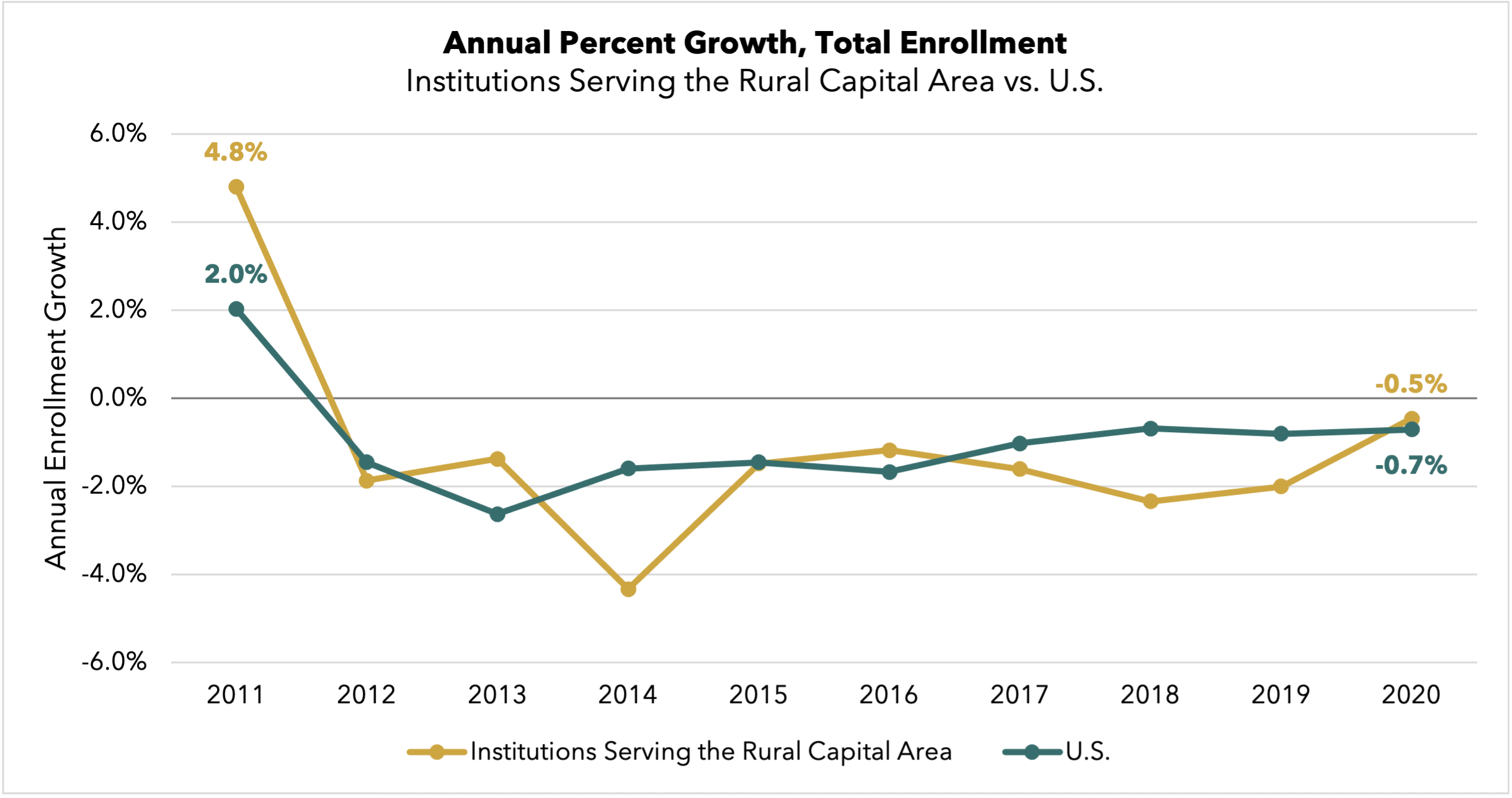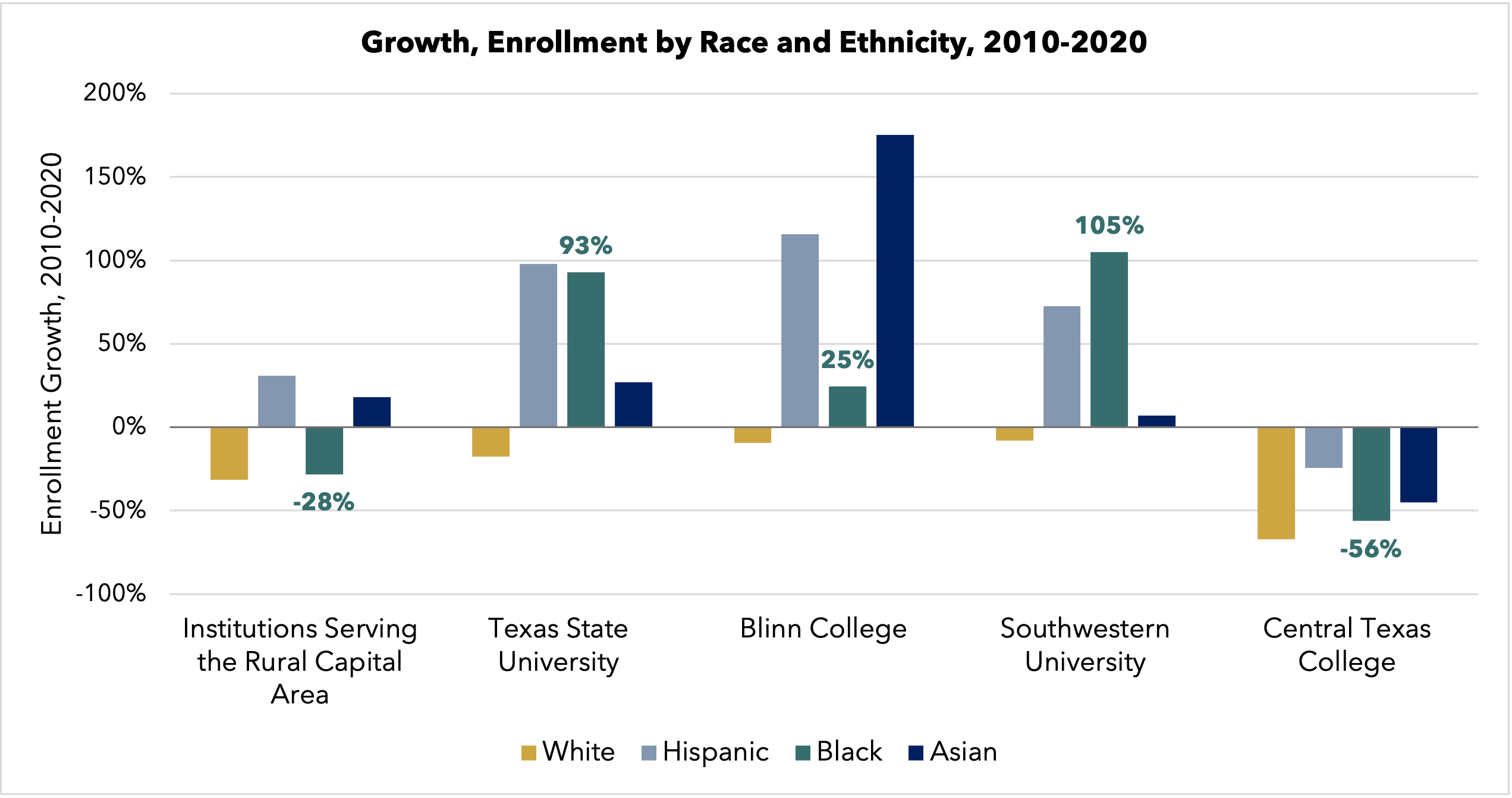A recent analysis of college graduate data from the Rural Capital Area revealed that the total number of graduates entering the workforce has declined in the last five years. The number of graduates decreased in programs such as business, finance, education, hospitality, healthcare, mechanics, etc., leading to questions about how college enrollment more generally has played into this emerging trend. Could shrinking enrollment numbers from the last decade be impacting the number of graduates today?
The answer appears the be yes. The data reveals that, on average, institutions serving the RCA (from here forward, referred to as local colleges) have seen their student populations decline in the last decade, consistent with national trends. From 2010 to 2020, enrollment at local colleges decreased by more than 30,000 students, roughly 12 percent. Nationally, enrollment decreased by a similar 10 percent. The chart below shows that this has been an ongoing trend since 2011, the last time local and national schools saw their enrollment numbers increase from the prior year. Every year since 2011 college and university enrollments have declined. Explore these data in greater detail here.

There has been speculation that the onset of the COVID-19 pandemic and resulting recession would reverse this decade-long trend. Research shows that historically college enrollment grows as the unemployment rate grows, especially for younger workers aged 16-24. Typically, during a recession, the lack of employment opportunities and depressed wages decreases the opportunity cost of going to college and individuals enroll in school to delay entering a job market with fewer prospects.
However, while 2021 and 2022 enrollment data are not yet available for local colleges, emerging data suggests that nationally, the pandemic “turbo charged the declines at the undergraduate level”. With the growing demand for workers and recent pay increases for service jobs to attract talent, colleges’ traditional audience, young adults, are forgoing college enrollment at greater numbers. In March 2022, the unemployment rate for people aged 15-24 in the U.S. was 8.2%, the lowest it has been since 1969 (excluding a February 2020 rate of 7.9%).
Turning back to the RCA, there are some local colleges that managed to buck the trend over the last decade and grow their student populations while enrollment in the rest of the country declined. Texas State University, Blinn College, and Southwestern University (a private institution) grew enrollment rates by between 14% to 21% since 2010. The University of Texas at Austin retained stable enrollment. The table below highlights these changes.
|
Institution |
% Enrollment Change, 2010-2020 |
Enrollment Change 2010-2020 |
2020 Enrollment |
|
Texas State University |
20.8% |
7,279 |
42,292 |
|
Blinn College |
15.7% |
3,940 |
29,010 |
|
Southwestern University |
13.5% |
186 |
1,562 |
|
The University of Texas at Austin |
0.0% |
(21) |
54,243 |
|
Austin Community College District |
-9.6% |
(6,757) |
63,569 |
|
Temple College |
-13.5% |
(1,096) |
7,008 |
|
Victoria College |
-17.2% |
(974) |
4,687 |
|
Central Texas College |
-52.1% |
(24,863) |
22,886 |
One reason for the different institutional enrollment rates may be each school’s ability to attract and retain a diverse student body. Across the RCA, White and Black student enrollment declined from 2010 to 2020, while Hispanic and Asian student enrollment increased. The only three institutions that grew enrollment are also the only three institutions that managed to grow Black student enrollment rates in the same time frame. These three schools’ Hispanic and Asian growth rates also outpaced the regional average. For comparison, Central Texas college saw declines across each demographic group. See the chart below.

Absolute numbers, as opposed to percentages, would be needed to calculate just how much of each schools’ growth can be attributed to demographic differences. However, the data tell and clear and consistent story overall. Declining enrollment in higher education stands to impact graduation rates, and therefore talent availability, for years to come in the RCA and across the country. Higher education providers need solutions to diversify their student bodies, not only in terms of race and ethnicity but also in age and previous experience, i.e., adult learners and non-traditional college students, to continue to train the talent of tomorrow.